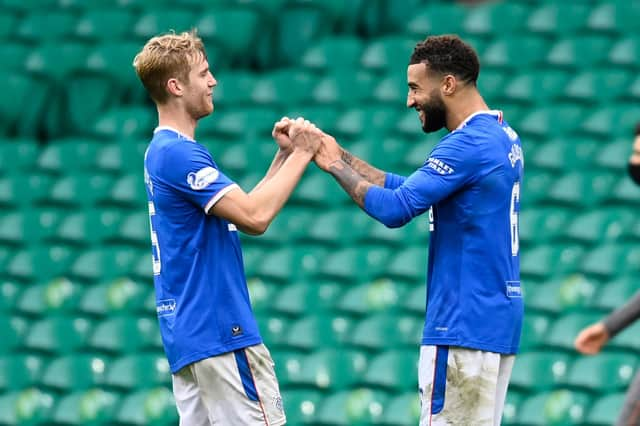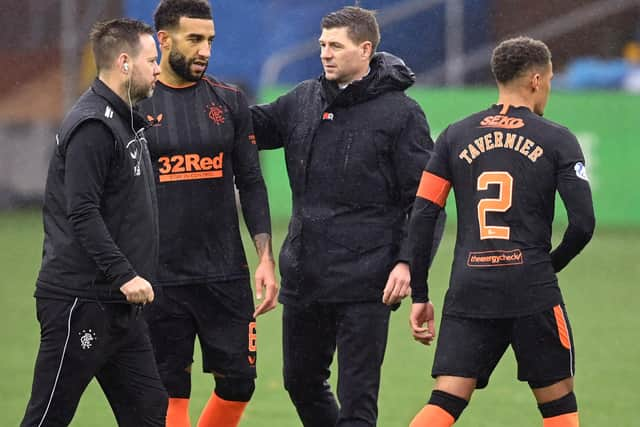The REMARKABLE numbers behind Rangers' defensive success which explains their position ahead of Celtic


Steven Gerrard’s men have opened up a nine point lead at the top of the table following their 1-0 win at Kilmarnock.
It was a tricky fixture for the Ibrox side at a ground where they have come unstuck in the past. Since Gerrard took over they have lost three of six games at Rugby Park.
Advertisement
Hide AdAdvertisement
Hide AdRangers may not have been at their sparkling best but did more than enough without being overly troubled.
Perhaps the most surprising aspect was the four shots on target Kilmarnock achieved during the match. It was the second highest number recorded by a team against the Rangers this season.
Only Willem II in Europa League qualifying and Hibs in the league have recorded more – both hitting the target five teams.
Pre-Gerrard v Present-Gerrard
Supporters have become accustomed to the team not conceding any, so much so that it is almost seen as an affront for Allan McGregor to be tested. And it’s not just happening against lesser teams. Celtic, Lech Poznan and Standard Liege have all been unable to work the goalkeeper.


Prior to Gerrard’s arrival the Rangers defence was in relative terms a shambles considering the club’s aims. In the two seasons before the Liverpool legend made the move the team conceded a combined 94 goals in the league. It worked out at 1.1 goals conceded per 90 minutes in 2016/17 then rose to 1.24 in 2017/18. Not exactly title-winning material.
Gerrard's first season saw it drop to 0.67 per 90. Last campaign it was 0.62 per game.
Currently, with only three goals conceded in 13 matches it stands at a hugely impressive 0.22 per 90. Essentially, Rangers are conceding a goal every four and a bit games.
The impressive stats don’t stop there.
You shall not pass… or shoot
As alluded to above, the reason Rangers are conceding so few goals is because they are giving up barely any shots.
Advertisement
Hide AdAdvertisement
Hide AdIn total this season, opponents have attempted just 60 shots at a rate of 4.36 per 90. The league average for the campaign is 133.5. The team as a whole have had to block only 18 attempts also.
In terms of how many goals opposition teams should have scored against Rangers in the league, the expected goals against figure is 5.76, according to Wyscout. When the team do give up shooting opportunities they do so in areas which make it very difficult for players to score.
The xGA per shot (the likelihood of a shot ending as a goal with 1 being the highest) is just 0.096, the second best ranking in the league behind St Johnstone surprisingly. It means that teams are either attempting speculative efforts or from areas which make it difficult to get a solid effort in at goal.
Sometimes with dominant teams you find the chances they do give up have a higher xGA because they can leave space in behind their defence. That is not the case with Rangers.
Suffocating control
It is aided by the control the Gerrard’s men exert on games. No team passes the ball more (566.08 on average per 90). They are just behind Celtic when it comes to ball possession and pass success rate. The former is 65.3 per cent and the latter is 87 per cent.
They have the ball for most of the game and very rarely give it away. It comes down to the team being hard to press.
Having such dominance pushes teams back and saps their energy to the point where they can feel they are suffocating. When the opposition do get the ball it can be rushed as they try to take quick breaths. And they have to take quick breaths and launch quick attacks, either that or be very confident in their possession play because Rangers are good at winning the back back.
When it comes to challenge intensity – duels, tackles and interceptions per minute of opponent possession – no team has a better figure and they allow the second fewest passes per defensive action.
Advertisement
Hide AdAdvertisement
Hide AdAgain, this means that when they don’t have the ball they aren’t sitting off teams but striving to win it back whether it be through tackles, interceptions or pressure as they lay traps for teams to fall into.
Collective as well as individual
A number of Rangers players have come in for praise this season, from the back to the front. Connor Goldson has been excellent, no matter if it is alongside the slick Filip Helander or the imposing Leon Balogun.
Helander especially has been excellent at winning his defensive duels, while Goldson is one of the best in the league at defending balls into the box.
You also can’t underestimate James Tavernier and Borna Barisic’s defensive contribution but in an attacking sense. Both players are so dangerous going forward that it takes a very brave manager to push wingers on to them and almost free them up from tracking the Rangers duo back as they surge forward. It comes down to risk and reward.
But for Steven Gerrard, it is not about individuals or the defence but the collective. As a team they have the second best defensive duel success rate in the league, just behind St Johnstone and three percentage points higher than Celtic. These numbers can matter.
Last season, Rangers’ title challenge fell away after the winter break due to a drop in the team’s attacking output.
With the defence performing even better this campaign, they continue to give Steven Gerrard’s side the most solid of platforms for success.